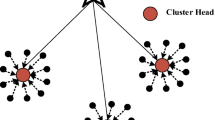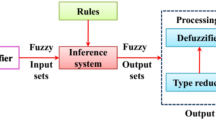Abstract
In the design of Wireless sensor networks (WSNs), maximizing network lifetime and sustaining energy stability is identified as the challenging problem since it comprises of compact sized and energy limited sensor nodes that cooperates during data routing. The existing clustering-based routing mechanisms accomplished energy efficiency and attempted to minimize the distance between the cluster head (CH) and the sink node for network lifetime improvement. The adoption of swarm intelligence algorithms and fuzzy logic is determined to the ideal computational intelligence techniques which are suitable for NP-hard problem like the multi-hop route selection process. In this paper, A Modified Dingo Optimization Algorithm-based Clustering Mechanism (MDOACM) is proposed for addressing the limitations of the clustering protocol with respect to cluster head (CH) lifetime and cluster quality. This MDOACM-based clustering protocol utilized Interval Type-2 Fuzzy Logic (IT2FL) for determining the trust level of each sensor node since the existence of an untrustworthy node introduces adverse impact on the data quality and reliability. It specifically used MDOA for achieving better clustering with balanced trade-off between the rate of exploration and exploitation such that frequent re-clustering is prevented. It effectively prevented malicious nodes with minimized energy consumption and enhanced network lifetime. It also adopted a communication system that supports the sensors in attaining the objective with reduced energy and maximized confidence level during the transmission of full exploration data. The results of MDOACM confirmed an average improvement in network lifetime of 23.18% and 25.16% with respect to different energy levels and density of sensor nodes.
















Similar content being viewed by others
Data availability
Data sharing not applicable – no new data generated.
References
Mittal N, Singh S, Singh U, Salgotra R (2021) Trust-aware energy-efficient stable clustering approach using fuzzy type-2 Cuckoo search optimization algorithm for wireless sensor networks. Wireless Netw 27:151–174
Vasanthi G, Prabakaran N (2022) Reliable network lifetime and energy-aware routing protocol for wireless sensor network using hybrid particle swarm-flower pollination search algorithm. J Ambient Intell Humanized Comput 14(12):16183–16193
Sajan RI, Christopher VB, Kavitha MJ, Akhila TS (2022) An energy aware secure three-level weighted trust evaluation and grey wolf optimization-based routing in wireless ad hoc sensor network. Wireless Netw 28(4):1439–1455
Janakiraman S (2023) Improved bat optimization algorithm and enhanced artificial bee colony-based cluster routing scheme for extending network lifetime in wireless sensor networks. Int J Commun Syst 36(5):e5428
Balamurugan A, Janakiraman S, Priya MD, Malar ACJ (2022) Hybrid Marine predators’ optimization and improved particle swarm optimization-based optimal cluster routing in wireless sensor networks (WSNs). China Commun 19(6):219–247
Sengathir J, Deva Priya M, Nithiavathy R, Sam Peter S (2023) COPRAS-Based Decision-Making Strategy for Optimal Cluster Head Selection in WSNs. In Proceedings of International Conference on Recent Trends in Computing: ICRTC 2022. Singapore: Springer Nature Singapore pp. 537–549
Mittal N (2020) An energy efficient stable clustering approach using fuzzy type-2 bat flower pollinator for wireless sensor networks. Wireless Pers Commun 112:1137–1163
Balamurugan A, Janakiraman S, Priya DM (2022) Modified African buffalo and group teaching optimization algorithm-based clustering scheme for sustaining energy stability and network lifetime in wireless sensor networks. Trans Emerg Telecommun Technol 33(1):78–92
Rajeswarappa G, Vasundra S (2021) Red deer and simulation annealing optimization algorithm-based energy efficient clustering protocol for improved lifetime expectancy in wireless sensor networks. Wireless Pers Commun 121(3):2029–2056
Jayalakshmi P, Sridevi S, Janakiraman S (2021) A hybrid artificial bee colony and harmony search algorithm-based metahueristic approach for efficient routing in WSNs. Wireless Pers Commun 121(4):3263–3279
Pratha SJ, Asanambigai V, Mugunthan SR (2023) A modified whale-dragonfly algorithm and self-adaptive cuckoo search-based clustering strategy for augmenting network lifetime in wireless sensor networks. Int J Commun Syst 36:e5482
Alamelu RM, Prabu K (2022) Hybridization of Pigeon inspired with glowworm’swarm optimization-based clustering technique in wireless sensor networks. Microprocess Microsyst 91:104528
Samiayya D, Radhika S, Chandrasekar A (2023) An optimal model for enhancing network lifetime and cluster head selection using hybrid snake whale optimization. Peer-to-Peer Netw Appl 16(4):1959–1974
Pratha SJ, Asanambigai V, Mugunthan SR (2023) Hybrid Mutualism Mechanism-Inspired Butterfly and Flower Pollination Optimization Algorithm for Lifetime Improving Energy-Efficient Cluster Head Selection in WSNs. Wireless Pers Commun 128(3):1567–1601
Bairwa AK, Joshi S, Singh D (2021) Dingo optimizer: a nature-inspired metaheuristic approach for engineering problems. Math Probl Eng 2021:1–12
Peraza-Vázquez H, Peña-Delgado AF, Echavarría-Castillo G, Morales-Cepeda AB, Velasco-Álvarez J, Ruiz-Perez F (2021) A bio-inspired method for engineering design optimization inspired by dingoes hunting strategies. Math Probl Eng 2021:1–19
Almazán-Covarrubias JH, Peraza-Vázquez H, Peña-Delgado AF, García-Vite PM (2022) An improved Dingo optimization algorithm applied to SHE-PWM modulation strategy. Appl Sci 12(3):992
Maheshwari P, Sharma AK, Verma K (2021) Energy efficient cluster-based routing protocol for WSN using butterfly optimization algorithm and ant colony optimization. Ad Hoc Netw 110:102317
Sheriba ST, Rajesh DH (2021) Energy-efficient clustering protocol for WSN based on improved black widow optimization and fuzzy logic. Telecommun Syst 77(1):213–230
Esmaeili H, Hakami V, Bidgoli BM, Shokouhifar M (2022) Application-specific clustering in wireless sensor networks using combined fuzzy firefly algorithm and random forest. Expert Syst Appl 210:118365
Yang Y, Wu Y, Yuan H, Khishe M, Mohammadi M (2022) Nodes clustering and multi-hop routing protocol optimization using hybrid chimp optimization and hunger games search algorithms for sustainable energy efficient underwater wireless sensor networks. Sustain Comput: Inform Syst 35:100731
Sengathir J, Rajesh A, Dhiman G, Vimal S, Yogaraja CA, Viriyasitavat W (2022) A novel cluster head selection using Hybrid Artificial Bee Colony and Firefly Algorithm for network lifetime and stability in WSNs. Connect Sci 34(1):387–408
Vazhuthi PPI, Prasanth A, Manikandan SP, Sowndarya KD (2023) A hybrid ANFIS reptile optimization algorithm for energy-efficient inter-cluster routing in internet of things-enabled wireless sensor networks. Peer-to-Peer Netw Appl 16(2):1049–1068
Rami Reddy M, Ravi Chandra ML, Venkatramana P, Dilli R (2023) Energy-efficient cluster head selection in wireless sensor networks using an improved grey wolf optimization algorithm. Computers 12(2):35
Cherappa V, Thangarajan T, Meenakshi Sundaram SS, Hajjej F, Munusamy AK, Shanmugam R (2023) Energy-Efficient Clustering and Routing Using ASFO and a Cross-Layer-Based Expedient Routing Protocol for Wireless Sensor Networks. Sensors 23(5):2788
Biradar M, Mathapathi B (2023) Security and Energy Aware Clustering-Based Routing in Wireless Sensor Network: Hybrid Nature-Inspired Algorithm for Optimal Cluster Head Selection. J Interconnection Netw 23(01):2150039
Mittal N, Singh S, Nayyar A, Singh U (2023) Hybrid sooty tern naked mole-rat algorithm and Fuzzy Type-2 logic-based trust and energy-aware stable clustering protocol. Expert Syst Appl 219:119706
Raghavendra YM, Mahadevaswamy UB (2023) Hybrid rendezvous clustering model for efficient data collection in multi sink based wireless sensor networks. Wireless Pers Commun 129(2):837–851
Raghavendra YM, Mahadevaswamy UB (2023) SBLDAR: A Link Score Based Delay Aware Routing for WSNs. Wireless Pers Commun 132(1):629–650
Raghavendra YM, Mahadevaswamy UB (2021) Energy efficient intra cluster gateway optimal placement in wireless sensor network. Wireless Pers Commun 119:1009–1028
Raghavendra YM, Mahadevaswamy UB (2020) Energy efficient routing in wireless sensor network based on mobile sink guided by stochastic hill climbing. Int J Electr Comput Eng (IJECE) 10(6):5965–5973
Dubey K, Rajpoot P, Singh AK, Kumar A, Yaduvanshi R (2019) Fuzzy based Technique for Nodes Coverage with Load Balancing Data collection using Multiple Conflicting Factors. In 2019 International Conference on Communication and Electronics Systems (ICCES) (pp. 579–584). IEEE
Ali A, Ali A, Masud F, Bashir MK, Zahid AH, Mustafa G, Ali Z (2024) Enhanced Fuzzy Logic Zone Stable Election Protocol for Cluster Head Election (E-FLZSEPFCH) and Multipath Routing in wireless sensor networks. Ain Shams Eng J 15(2):102356
Rajpoot P, Dwivedi P (2018) Matrix method for non-dominated sorting and population selection for next generation in multi-objective problem solution. In 2018 8th International Conference on Cloud Computing, Data Science & Engineering (Confluence) 21(6):670–676. IEEE
Pedditi RB, Debasis K (2024) MACR: A Novel Meta-Heuristic Approach to Optimize Clustering and Routing in IoT-based WSN. Int J Intell Syst Appl Eng 12(1):346–359
Rai AK, Daniel AK (2023) FEEC: fuzzy based energy efficient clustering protocol for WSN. Int J Syst Assur Eng Manag 14(1):297–307
Saini R, Dubey K, Rajpoot P, Gautam S, Yaduvanshi R (2021) Lifetime Maximization of Heterogeneous WSN using Fuzzy-based Clustering. Recent Adv Comput Sci Commun (Formerly: Recent Patents Comput Sci) 14(9):3025–3039
Rajpoot P, Dwivedi P (2020) Optimized and load balanced clustering for wireless sensor networks to increase the lifetime of WSN using MADM approaches. Wireless Netw 26(1):215–251
Panbude S, Iyer B, Nandgaonkar AB, Deshpande PS (2023) DFPC: Dynamic Fuzzy-based Primary User Aware clustering for Cognitive Radio Wireless Sensor Networks. Eng Technol Appl Sci Res 13(6):12058–12067
Narayan V, Daniel AK, Chaturvedi P (2023) E-FEERP: Enhanced Fuzzy based Energy Efficient Routing Protocol for Wireless Sensor Network. Wirel Pers Commun 23(8):1–28
Rajpoot P, Dwivedi P (2019) Multiple parameter-based energy balanced and optimized clustering for WSN to enhance the Lifetime using MADM Approaches. Wirel Pers Commun 106:829–877
Jayaraman G, Dhulipala VS (2022) FEECS: fuzzy-based energy-efficient cluster head selection algorithm for lifetime enhancement of wireless sensor networks. Arab J Sci Eng 47(2):1631–1641
Funding
There is no funding received for this research work.
Author information
Authors and Affiliations
Contributions
Kishore Verma S formulated the problem, Lokeshwaran K implemented, conducted the literature review, Martin Sahayaraj J written the complete text, performed the experimental validation process and Adeline Johnsana J S reviewed the complete manuscript.
Corresponding author
Ethics declarations
Ethics approval
Not applicable.
Consent for publication
Subscription only.
Competing interests
The author declare that there is no competing interest.
Additional information
Publisher's Note
Springer Nature remains neutral with regard to jurisdictional claims in published maps and institutional affiliations.
Rights and permissions
Springer Nature or its licensor (e.g. a society or other partner) holds exclusive rights to this article under a publishing agreement with the author(s) or other rightsholder(s); author self-archiving of the accepted manuscript version of this article is solely governed by the terms of such publishing agreement and applicable law.
About this article
Cite this article
Verma, S.K., Lokeshwaran, K., Sahayaraj, J.M. et al. Energy efficient multi-objective cluster-based routing protocol for WSN using Interval Type-2 Fuzzy Logic modified dingo optimization. Peer-to-Peer Netw. Appl. (2024). https://doi.org/10.1007/s12083-024-01696-w
Received:
Accepted:
Published:
DOI: https://doi.org/10.1007/s12083-024-01696-w




